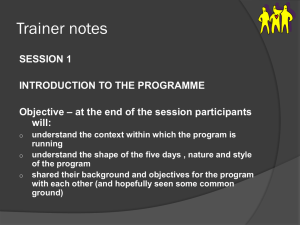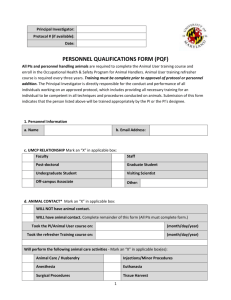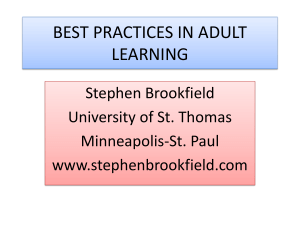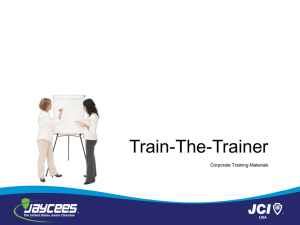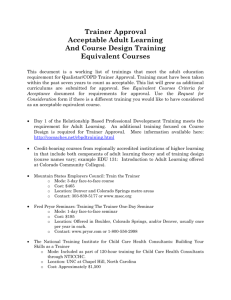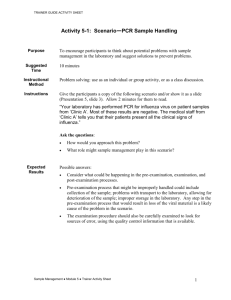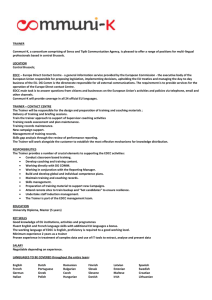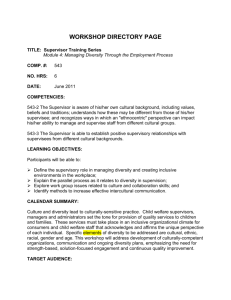How to Monitor a Training - University of New Hampshire
advertisement
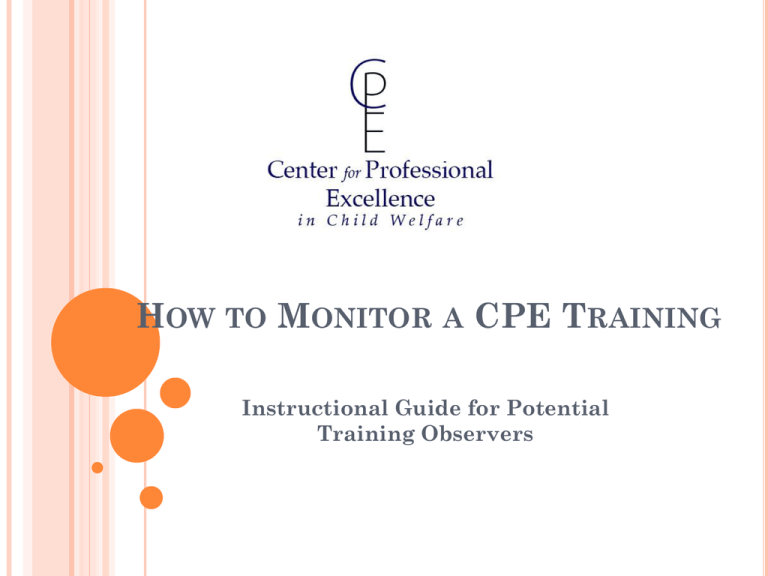
HOW TO MONITOR A CPE TRAINING Instructional Guide for Potential Training Observers WHAT IS MONITORING? Monitoring is a structured process of: observation data collection inspection Your job is to observe, judge, and record objectively and impartially. WHY MONITOR??? Ensures that training programs: are planned & delivered in a format suitable for both content and audience effectively impact job performance meet the needs of trainees as identified are in compliance with state and federal regulations justify the expenditure of resources BEFORE THE TRAINING Print and review monitoring form. Review the Principles of Adult Learning (discussed in later slides). If you have any questions, comments or concerns please contact UNH CPE at: (603)271-4732 TRAINING DAY! • • • • • Arrive at the training location at least 30 minutes early! Introduce yourself to the trainer. Explain who you are and why you are present. If possible find a seat that is somewhat removed from the participants that allows you room to observe but not interfere with the training. Be courteous, engaged and do not bring other work into the training. Remember! You are at the training to observe and assess NOT as a participant! Materials Needed: Pen/pencil, paper to take notes, the printed monitoring form and please obtain a copy of all training materials from the trainer. COMPLETING THE MONITORING FORM Complete the monitoring form throughout the course of the training. Follow all instructions on the form. Provide as much detail as possible! Use specific examples. For example: “The training materials reflected best case practice, were colorful and comprehensive.” COMPLETING THE MONITORING FORM CONTINUED… • Avoid using first person. • • For example: “I think that…”, “I found...”, “I liked…” Use objective language and explain statements. • For example:, Rather than: “The trainer did a good job,” use: “The trainer effectively engaged the audience, by…” *Remember!* The trainer will have access to the content of the monitoring report. ADULT LEARNING THEORY Addresses the ways in which adults learn best. There are 6 Principles Trainers that meet all 6 principles are most effective. The following slides address each principle followed by relevant training practices. PRINCIPLE 1: ADULTS ARE INTERNALLY MOTIVATED AND SELF-DIRECTED Trainers role: • • • Facilitate student’s movement toward more self-directed and responsible learning. Foster student’s internal motivation to learn Examples of what a trainer can do: • • • • • • • • • • Develop rapport with participants/students Encourage questions Show interest in student’s thoughts/opinions. Actively and carefully listen! Use student inquiry to direct information. Provide regular, constructive and specific feedback (positive and negative) Review goals and acknowledge goal completion Encourage use of resources such as library, journals, internet and other department resources. Recognize the preferred learning styles of the students PRINCIPLE 2: ADULTS BRING LIFE EXPERIENCES AND KNOWLEDGE TO LEARNING EXPERIENCES. • Trainer’s Role: Facilitate integration of student’s knowledge/experiences into the training. • Facilitate reflective learning opportunities: allow student to relate knowledge/experience to training/new information. • • Examples: Give students opportunity to use/share existing knowledge/experience in the training. • Encourage sharing of knowledge/experience • Validate previous knowledge/experiences. • Treat student’s as experts in what they do, i.e. knowledge of system, current practices etc. • PRINCIPLE 3: ADULTS ARE GOAL ORIENTED Trainer’s role: • Clearly illustrate the need for the information being provided in the training. Examples: Successfully provide links from training information to real world applications. • Integrates realistic/relevant case studies and scenarios. • Clearly outline course objectives that are relevant to work of intended audience. • PRINCIPLE 4: ADULTS ARE RELEVANCY ORIENTED Trainer’s Role: • Clearly demonstrate relevancy and value of training content for intended audience. Examples: • • Reflect with students on ways in which training content will be relevant to job performance. Find ways to relate student’s interests to training content. (Allow students to choose role plays, case scenarios etc… that relate to their own interests) PRINCIPLE 5: ADULTS ARE PRACTICAL • Trainer’s Role: • • Illustrate how training content can be realistically applied to real life/work. Examples: Through expertise/knowledge can provide examples of ways in which the learned knowledge/skills/training content can be used by the participants. • Demonstrate an understanding of the reality of work for students. • Provide opportunities for students to try new skills/information learned for themselves. • PRINCIPLE 6: ADULT LEARNERS LIKE TO BE RESPECTED Trainer’s Role • Demonstrate respectful, professional behavior. Examples: Actively listen to participants. • Treat participants as colleagues and equal. • Encourage expressions of ideas, reasoning and feedback at every opportunity. • Value experience/views of the participants • FINAL STEPS! • • Complete the monitoring form electronically. Submit completed form via e-mail to: Christie Davis Christie.davis@unh.edu Any questions comments or concerns please contact UNH CPE at: (603)271-4732 REFERENCES This Powerpoint presentation, as well as the newly created CPE Monitoring Form was informed by best practices in Child Welfare evaluation and based on the following research: Antle, B. F., Barbee, A. P., VanZyl, M. A., (2008). A comprehensive model for child welfare training evaluation. Children and Youth Services Review, volume 30, 1063-1080. Collins, M. E., Amodeo, M., Clay, C., (2007). Review of the literature on child welfare training: Theory, practice and research. Boston University School of Social Work. Curry, D., McCarragher, T., Dellman-Jenkins, M., (2005). Training, transfer and turnover: Exploring the relationship among transfer of learning factors and staff retention in child welfare. Children and Youth Services Review, volume, 27, 931-948. Lieb, S., (1991). Principles of adult learning. Vision, retrieved from: http://Honolulu.hawaii.edu/ intranet/committees/FaxDevCom/guidebk/teachtip/adults2.htm. Parry, C., Berdie, J., (2004). Training Evaluation Framework Report. California Social Work Education Center QOTFC, (2010). The clinical educator’s resource kit: Adult learning theory and principles. Retrieved from: http://www.qotfc.edu.au/resource/index.html?page=65375
